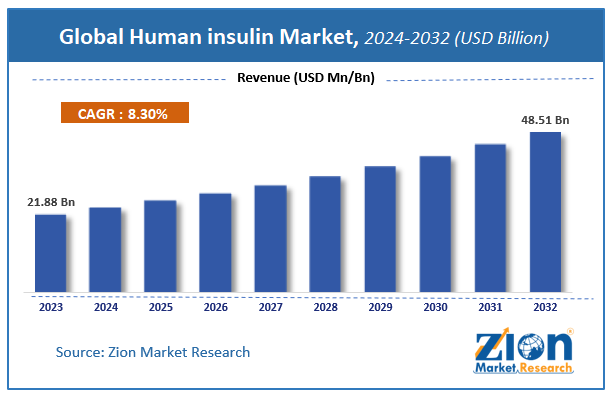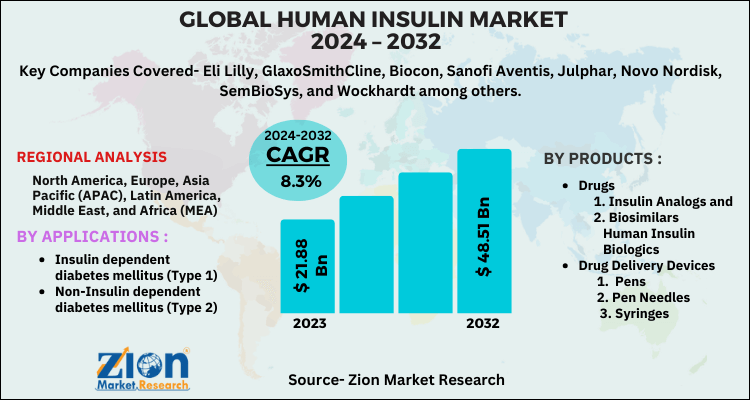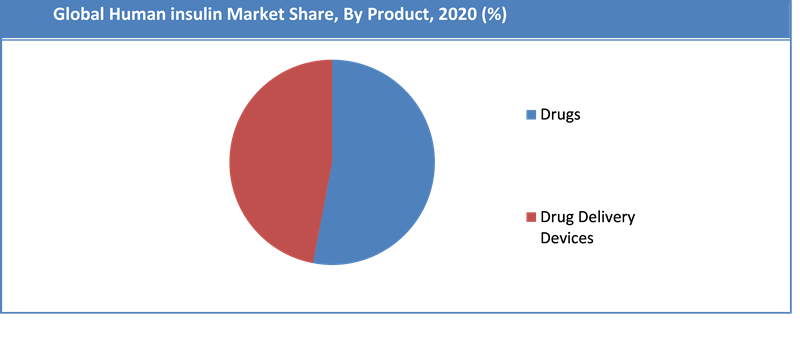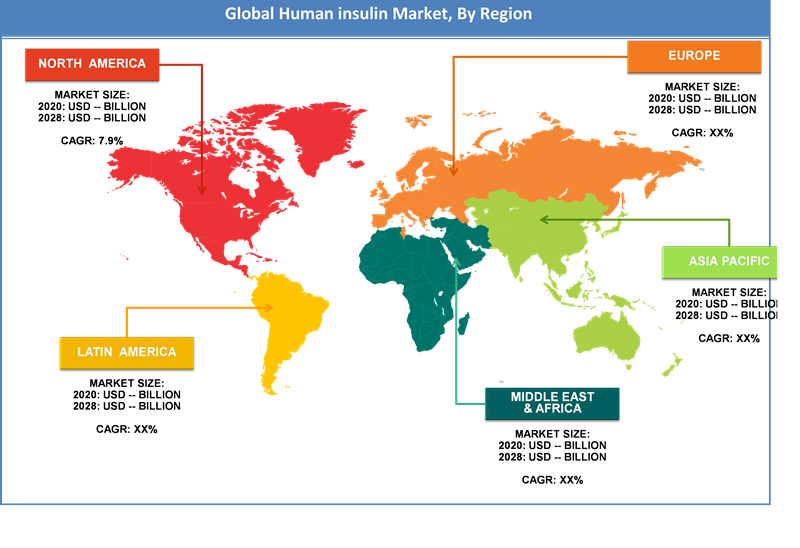Human insulin Market Size, Share Report, Analysis, Trends, Growth 2032
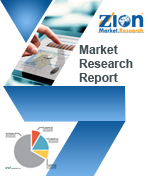
Human insulin Market by Product (Drugs and Drug Delivery Devices), By Application (Insulin dependent diabetes mellitus (Type 1) and Non-Insulin dependent diabetes mellitus (Type 2)), and by Region: Global Industry Perspective, Comprehensive Analysis and Forecast, 2024-2032
| Market Size in 2023 | Market Forecast in 2032 | CAGR (in %) | Base Year |
|---|---|---|---|
| USD 21.88 Billion | USD 48.51 Billion | 8.3% | 2023 |
Global Human insulin Market Insights
According to a report from Zion Market Research, the global Human insulin Market was valued at USD 21.88 Billion in 2023 and is projected to hit USD 48.51 Billion by 2032, with a compound annual growth rate (CAGR) of 8.3% during the forecast period 2024-2032. This report explores market strengths, weakness, opportunities, and threats. It also provides valuable insights into the market's growth drivers, challenges, and the future prospects that may emerge in the Human insulin Market industry over the next decade.
Human Insulin Market Overview
Human insulin is the term that describes synthetic insulin which is grown in a laboratory to mimic the insulin in humans. In a laboratory, it is created by growing insulin proteins within E-coli bacteria (Escherichia coli). It is mainly available in two forms, a short acting (regular) form and an intermediate acting (NPH) form. Human insulin was developed as an insulin that could be created in large amounts at a relatively low cost. It can be administered orally or through insulin infusion devices. Some conventional insulin infusion devices are syringes, insulin pumps, and injection pens. These devices are used to deliver insulin on time and regularly.
Diabetes is described as a group of metabolic diseases in which the person has high blood glucose level than normal, either because insulin production is inadequate, or because the body's cells do not respond properly to insulin. Diabetes is a lifelong condition that is characterized by a raised blood glucose level. Diabetes is characterized into two types of diabetes: Insulin dependent diabetes mellitus (type 1) and Non-insulin dependent diabetes mellitus (type 2). Signs of diabetes include an increased sense of thirst, frequent urination, fatigue, weight and muscle loss, delayed wound healing and blurred vision. Human insulin therapy is utilized for the treatment of both type1 and type 2 diabetes mellitus.
Human Insulin Market Growth Factors
The global human insulin market is likely to see noteworthy development in the years to come. This development in global human insulin market is attributed owing to the rising market demand for human insulin analogs, increasing risk of diabetes, favorable medical reimbursements, and technological enactments in the field of human insulin delivery devices. An insulin routine is often needed in the treatment of gestational diabetes and diabetes related with specific syndromes or conditions (such as chemical or drug-induced diabetes, pancreatic diseases, insulin-receptor disorders, endocrinopathies, and specific genetic syndromes). In all cases of insulin employment, the dosage of insulin must be balanced and individualized with exercise and medical nutrition therapy, thereby boosting the global human insulin market.
Human insulin Market: Report Scope
| Report Attributes | Report Details |
|---|---|
| Report Name | Human insulin Market |
| Market Size in 2023 | USD 21.88 Billion |
| Market Forecast in 2032 | USD 48.51 Billion |
| Growth Rate | CAGR of 8.3% |
| Number of Pages | 180 |
| Key Companies Covered | Eli Lilly, GlaxoSmithCline, Biocon, Sanofi Aventis, Julphar, Novo Nordisk, SemBioSys, and Wockhardt among others. |
| Segments Covered | By Product, By Drug Type, By Applications, and By Region |
| Regions Covered | North America, Europe, Asia Pacific (APAC), Latin America, Middle East, and Africa (MEA) |
| Base Year | 2023 |
| Historical Year | 2018 to 2022 |
| Forecast Year | 2024 - 2032 |
| Customization Scope | Avail customized purchase options to meet your exact research needs. Request For Customization |
Segment Analysis Preview
Based on products, the global human insulin market is segmented into two types: drugs and drug delivery devices. Drugs segment of human insulin market was contributing maximum market shares in 2015 followed by drug delivery devices. This segment is propelled by factors which include increasing in insulin dependent diabetic population, low cost, growing R&D for drug discovery, rising proportion of aging population in developed countries. In addition, increasing market accessibility of generic human insulin and rising government initiatives to support the development and commercialization of effective biosimilars are expected to fuel the growth of human insulin market over the forecast period
Based on drug type, the global human insulin market is segmented into two types: Biosimilars and Human Insulin Biologics. In terms of revenue, biosimilars were the leading segment of human insulin market in 2015 followed by human Insulin biologics. Meanwhile, biosimilar will rise approximately at a steady CAGR of 7.34% during the forecast period.
Based on application, the global human insulin market is segmented into two types: type 1 diabetes and type 2 diabetes. Type 1 diabetes mellitus was the dominating segment in terms of revenue generated in 2015 followed by type 2 diabetes mellitus. Type 1 Diabetes Mellitus is an autoimmune disorder characterized by a lack of insulin formation in the body. About 100,000 new cases are diagnosed annually in North America. Human insulin serves as only medication for treating type 1 diabetes mellitus.
Regional Analysis Preview
North America has been leading the worldwide human insulin market and is anticipated to continue on the dominant position in the years to come. The factors such as growing old age population, rising prevalence of diabetes, increasing healthcare awareness, improvement in reimbursement policies, and surge in clinical trials driving the growth of human insulin in North America.
Key Market Players & Competitive Landscape
Some of the major players of the global human insulin market include
- Eli Lilly
- GlaxoSmithCline
- Biocon
- Sanofi Aventis
- Julphar
- Novo Nordisk
- SemBioSys
- and Wockhardt among others.
The global Human insulin Market is segmented as follows:
By Products
- Drugs
- Insulin Analogs and Biosimilars
- Human Insulin Biologics
- Drug Delivery Devices
- Pens
- Pen Needles
- Syringes
By Applications
- Insulin dependent diabetes mellitus (Type 1)
- Non-Insulin dependent diabetes mellitus (Type 2)
By Region
- North America
- The U.S.
- Canada
- Europe
- France
- The UK
- Spain
- Germany
- Italy
- Rest of Europe
- Asia Pacific
- China
- Japan
- India
- South Korea
- Southeast Asia
- Rest of Asia Pacific
- Latin America
- Brazil
- Mexico
- Rest of Latin America
- Middle East & Africa
- GCC
- South Africa
- Rest of Middle East & Africa
Table Of Content
Methodology
FrequentlyAsked Questions
The global Human insulin Market was valued at USD 21.88 Billion in 2023.
The global Human insulin Market is expected to reach USD 48.51 Billion by 2032, growing at a CAGR of 8.3% between 2024 to 2032.
Some of the key factors driving the global Human insulin Market growth are the rising market demand for human insulin analogs, increasing risk of diabetes, favorable medical reimbursements, and technological enactments.
North America has been leading the worldwide human insulin market and is anticipated to continue on the dominant position in the years to come.
Some of the major players of global Human insulin market GlaxoSmithCline, Eli Lilly, Sanofi-Aventis, Biocon, Novo Nordisk, Julphar, Ypsomed AG, SemBioSys, and Wockhardt, among others.
RelatedNews
HappyClients
Zion Market Research
Tel: +1 (302) 444-0166
USA/Canada Toll Free No.+1 (855) 465-4651
3rd Floor,
Mrunal Paradise, Opp Maharaja Hotel,
Pimple Gurav, Pune 411061,
Maharashtra, India
Phone No +91 7768 006 007, +91 7768 006 008
US OFFICE NO +1 (302) 444-0166
US/CAN TOLL FREE +1 (855) 465-4651
Email: sales@zionmarketresearch.com
We have secured system to process your transaction.
Our support available to help you 24 hours a day, five days a week.
Monday - Friday: 9AM - 6PM
Saturday - Sunday: Closed

